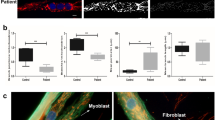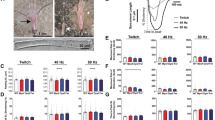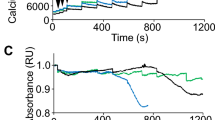Abstract
In an attempt to create an animal model of tissue-specif ic mitochondrial disease, we generated ‘knockout’ mice deficient in the heart/muscle isoform of the adenine nucleotide translocator (Ant1). Histological and ultrastructural examination of skeletal muscle from Ant1 null mutants revealed ragged-red muscle fibers and a dramatic proliferation of mitochondria, while examination of the heart revealed cardiac hypertrophy with mitochondrial proliferation. Mitochondria isolated from mutant skeletal muscle exhibited a severe defect in coupled respiration. Ant1 mutant adults also had a resting serum lactate level fourfold higher than that of controls, indicative of metabolic acidosis. Significantly, mutant adults manifested severe exercise intolerance. Therefore, Ant1 mutant mice have the biochemical, histological, metabolic and physiological characteristics of mitochondrial myopathy and cardiomyopathy.
This is a preview of subscription content, access via your institution
Access options
Subscribe to this journal
Receive 12 print issues and online access
$209.00 per year
only $17.42 per issue
Buy this article
- Purchase on Springer Link
- Instant access to full article PDF
Prices may be subject to local taxes which are calculated during checkout
Similar content being viewed by others
References
Shanske, S. & DiMauro, S. Mitochondrial myopathies: biochemical aspects. Curr. Top. Bioenerg. 17, 21–58 (1994).
Servidei, S., Bertini, E. & DiMauro, S. Hereditary metabolic cardiomyopathies. Adv. Pediatr. 41, 1–32 (1994).
Brown, M.D. & Wallace, D.C. Molecular basis of mitochondrial DNA disease. J. Bioenerg. Biomembr. 26, 273–289 (1994).
Klingenberg, M. Structure-function of the ADP/ATP carrier. Biochem. Soc. Trans. 20, 547–550 (1992).
O'Malley, K., Pratt, P., Robertson, J., Lilly, M. & Douglas, M.G. Selection of the nuclear gene for the mitochondrial adenine nucleotide translocator by genetic complementation of the op1 mutation in yeast. J. Biol. Chem. 257, 2097–2103 (1982).
Lawson, J.E. & Douglas, M.G. Separate genes encode functionally equivalent ADP/ATP carrier proteins in Saccharomyces cerevisiae: isolation and analysis of AAC2. J. Biol. Chem. 263, 14812–14818 (1988).
Kolarov, J., Kolarova, N. & Nelson, N. A third ADP/ATP translocator gene in yeast. J. Biol. Chem. 265, 12711–12716 (1990).
Rasmussen, U.B. & Wohlrab, H. Bovine cardiac mitochondrial ADP/ATP-carrier: two distinct mRNAs and an unusually short 3′-noncoding sequence. Biochem. Biophys. Res. Commun. 138, 850–857 (1986).
Powell, S.J., Medd, S.M., Runswick, M.J. & Walker, J.E. Two bovine genes for mitochondrial ADP/ATP translocase expressed differences in various tissues. Biochem. 28, 866–873 (1989).
Shinohara, Y., Kamida, M., Yamazaki, N. & Terada, H. Isolation and characterization of cDNA clones and a genomic clone encoding rat mitochondrial adenine nucleotide translocator. Biochim. Biophys. Acta 1152, 192–196 (1993).
Cozens, A.L., Runswick, M.J. & Walker, J.E. DNA sequences of two expressed nuclear genes for human mitochondrial ADP/ATP translocase. J. Mol. Biol. 206, 261–280 (1989).
Li, K. et al. A human muscle adenine nucleotide translocator gene has four exons, is located on chromosome 4, and is differentially expressed. J. Biol. Chem. 264, 13998–14004 (1989).
Chen, S.T. et al. A human ADP/ATP translocase gene has seven pseudogenes and localizes to chromosome X.Somat. Cell Mol. Genet 16, 143–149 (1990).
Ku, D.H. et al. The human fibroblast adenine nucleotide translocator gene: molecular cloning and sequence. j. Biol. Chem. 265, 16060–16063 (1990).
Stepien, G., Torroni, A., Chung, A.B., Hodge, J.A. & Wallace, D.C. Differential expression of adenine nucleotide translocator isoforms in mammalian tissues and during muscle cell differentiation. j. Biol. Chem. 267, 14592–14597 (1992).
Wallace, D.C. et al. Mitochondrial DNA mutations in human degenerative diseases and aging. Biochim. Biophys. Acta 1271, 141–151 (1995).
Mills, K.A., Ellison, J.W. & Mathews, K.D., Ant1 gene maps near Klk3 on proximal mouse chromosome 8. Mamm. Genome 7, 707 (1996).
Haraguchi, Y. et al. Genetic mapping of human heart-skeletal muscle adenine nucleotide translocator and its relationship to the facioscapulohumeral muscular dystrophy locus. Genomics 16, 479–485 (1993).
Wijmenga, C. et al. The human skeletal muscle adenine nucleotide translocator gene maps to chromosome 4q35 in the region of the facioscapulohumeral muscular dystrophy locus. Hum. Genet. 92, 198–203 (1993).
Ellison, J.W., Li, X., Francke, U. & Shapiro, L.J. Rapid evolution of human pseudoautosomal genes and their mouse homologs. Mamm. Genome 7, 25–30 (1996).
Friedrich, G. & Soriano, P. Promoter traps in embryonic stem cells: a genetic screen to identify and mutate developmental genes in mice. Genes Dev. 5, 1513–1523 (1991).
Schambra, U.B., Lauder, J.M. & Silver, J. Atlas of the Prenatal Mouse Brain 1–327 (Academic Press, San Diego, 1992).
DiMauro, S., Bonilla, E., Zeviani, M., Nakagawa, M. & DeVivo, D.C. Mitochondrial myopathies. Ann. Neurol. 17, 521–538 (1985).
Barth, E., Stammler, G., Speiser, B. & Schaper, J. Ultrastructural quantitation of mitochondria and myof ilaments in cardiac muscle from 10 different animal species including man. J. Mol. Cell. Cardiol. 24, 669–681 (1992).
Hatchell, P.L. & Maclnnes, J.W. A quantitative analysis of the genetics of resting blood lactic acid levels in mice. Genetics 75, 191–198 (1973).
Munnich, A. et al. Clinical presentations and laboratory investigations in respiratory chain deficiency. Eur. J. Pediatr. 155, 262–274 (1996).
Wallace, D.C. et al. Familial mitochondrial encephalomyopathy (MERRF): genetic, pathophysiological, and biochemical characterization of a mitochondrial DNA disease. Cell 55, 601–610 (1988).
Wasserman, K., Hansen, J.E., Sue, D.Y. & Whipp, B.J. Principles of Exercise Testing and Interpretation, 1–274 (Lea & Febiger, Philadelphia, 1987).
Bakker, H.D. et al. Deficiency of the adenine nucleotide translocator in muscle of a patient with myopathy and lactic acidosis: a new mitochondrial defect. Pediatr. Res. 33, 412–417 (1993).
Bakker, H.D. et al. Adenine nucleotide translocator deficiency in muscle: potential therapeutic value of vitamin E. J. Inherit. Metab. Dis. 16, 548–552 (1993).
Wallace, D.C. 1994 William Allan Award Address. Mitochondrial DNA variation in human evolution, degenerative disease, and aging. Am. J. Hum. Genet. 57, 201–223 (1995).
Pette, D. & Vrbova, G. Neural control of phenotypic expression in mammalian muscle fibers. Muscle Nerve 8, 676–689 (1985).
Salmons, S. & Henriksson, J. The adaptive response of skeletal muscle to increased use. Muscle Nerve 4, 94–105 (1981).
Williams, R.S., Salmons, S., Newsholme, E.A., Kaufman, R.E. & Mellor, J. Regulation of nuclear and mitochondrial gene expression by contractile activity in skeletal muscle. j. Biol. Chem. 261, 376–380 (1986).
Levak-Frank, S. et al. Muscle-specific overexpression of lipoprotein lipase causes a severe myopathy characterized by proliferation of mitochondria and peroxisomes in transgenic mice. j. Clin. Invest. 96, 976–986 (1995).
Chung, A.B., Stepien, G., Haraguchi, Y., Li, K. & Wallace, D.C. Transcriptional control of nuclear genes for the mitochondrial muscle ADP/ATP translocator and the ATP synthase beta subunit.Multiple factors interact with the OXBOX/REBOX promoter sequences. j. Biol. Chem. 267, 21154–21161 (1992).
Haraguchi, Y., Chung, A.B., Neill, S. & Wallace, D.C. OXBOX and REBOX, overlapping promoter elements of the mitochondrial FOF1-ATP synthase beta subunit gene.OXBOX/REBOX in the ATPsyn beta promoter. j Biol. Chem. 269, 9330–9334 (1994).
Li, K., Hodge, J.A. & Wallace, D.C. OXBOX, a positive transcriptional element of the heart-skeletal muscle ADP/ATP translocator gene. j. Biol. Chem. 265, 20585–20588 (1990).
Neckelmann, N., Li, K., Wade, R.P., Shuster, R. & Wallace, D.C. cDNA sequence of a human skeletal muscle ADP/ATP translocator: lack of a leader peptide, divergence from a fibroblast translocator cDNA, and coevolution with mitochondrial DNA genes. Proc. Natl. Acad. Sci. USA 84, 7580–7584 (1987).
Sambrook, J., Fritsch, E.F. & Maniatis, T., Cloning: a Laboratory Manual (Cold Spring Harbor Laboratory Press, New York, 1989).
Battini, R. et al. Molecular cloning of a cDNA for a human ADP/ATP carrier which is growth-regulated. J. Biol. Chem. 262, 4355–359 (1987).
Pfanner, N. & Neupert, W. Distinct steps in the import of ADP/ATP carrier into mitochondria. J. Biol. Chem. 262, 7528–7536 (1987).
Lowry, O.H., Rosenbrough, N.J., Farr, A.L. & Randall, R.J. Protein measurement with the Folin phenol reagent. j. Biol. Chem. 193, 265–275 (1951).
MacGregor, G.R., Zambrowicz, B.P. & Soriano, P. Tissue nonspecific alkaline phosphatase is expressed in both embryonic and extraembryonic lineages during mouse embryogenesis but is not required for migration of primordial germ cells. Development 121, 1487–1496 (1995).
Soriano, P., Montgomery, C., Geske, R. & Bradley, A. Targeted disruption of the c-src proto-oncogene leads to osteopetrosis in mice. Cell 64, 693–702 (1991).
Ramirez-Solis, R., Davis, A.C. & Bradley, A. Gene targeting in embryonic stem cells, in Guide to Techniques in Mouse Development, Vol. 225 (eds Wassarman, P.M. & DePamphilis, M.L.) 855–878 (Academic Press, San Diego, 1993).
Stewart, C.L. Production of chimeras between embryonic stem cells and embryos, in Guide to Techniques in Mouse Development, Vol. 225 (eds Wassarman, P.M. & DePamphilis, M.L) 823–855 (Academic Press, San Diego, 1993).
Dubowitz, V. Muscle biopsy: a practical approach (Lavenham Press, 1985).
Rifai, Z., Welle, S., Kamp, C. & Thornton, C.A. Ragged red fibers in normal aging and inflammatory myopathy. Ann. Neurol. 37, 24–29 (1995).
Sheehan, D.C. & Hrapschak, B.B. Theory and Practice of Histotechnology (Batelle Press, Columbus, Ohio, 1980).
Blau, D.M. & Compans, R.W. Entry and release of measles virus are polarized in epithelial cells. Virology 210, 91–99 (1995).
Trounce, I.A., Kim, Y.L., Jun, A.S. & Wallace, D.C. Assessment of mitochondrial oxidative phosphorylation in patient muscle biopsies, lymphoblasts, and transmitochondrial cell lines. Methods Enzymol. 264, 484–509 (1996).
Steel, B.F., Reynolds, M.S. & Baumann, C.A. Effect of diet on amino acids in blood and urine of mice of various ages. Arch. Biochem. 25, 124–132 (1950).
Author information
Authors and Affiliations
Rights and permissions
About this article
Cite this article
Graham, B., Waymire, K., Cottrell, B. et al. A mouse model for mitochondrial myopathy and cardiomyopathy resulting from a deficiency in the heart/muscle isoform of the adenine nucleotide translocator. Nat Genet 16, 226–234 (1997). https://doi.org/10.1038/ng0797-226
Received:
Accepted:
Issue Date:
DOI: https://doi.org/10.1038/ng0797-226
This article is cited by
-
Mtfp1 ablation enhances mitochondrial respiration and protects against hepatic steatosis
Nature Communications (2023)
-
Non-additive QTL mapping of lactation traits in 124,000 cattle reveals novel recessive loci
Genetics Selection Evolution (2022)
-
Mitochondrial Fission Process 1 controls inner membrane integrity and protects against heart failure
Nature Communications (2022)
-
Reply to “Correspondence to Ant1 mutant mice bridge the mitochondrial and serotonergic dysfunctions in bipolar disorder”
Molecular Psychiatry (2020)
-
TarGo: network based target gene selection system for human disease related mouse models
Laboratory Animal Research (2019)



